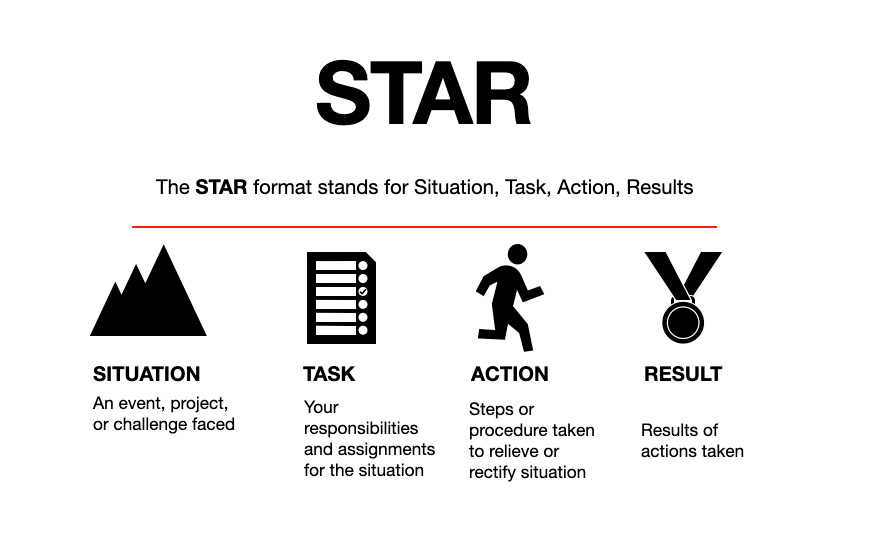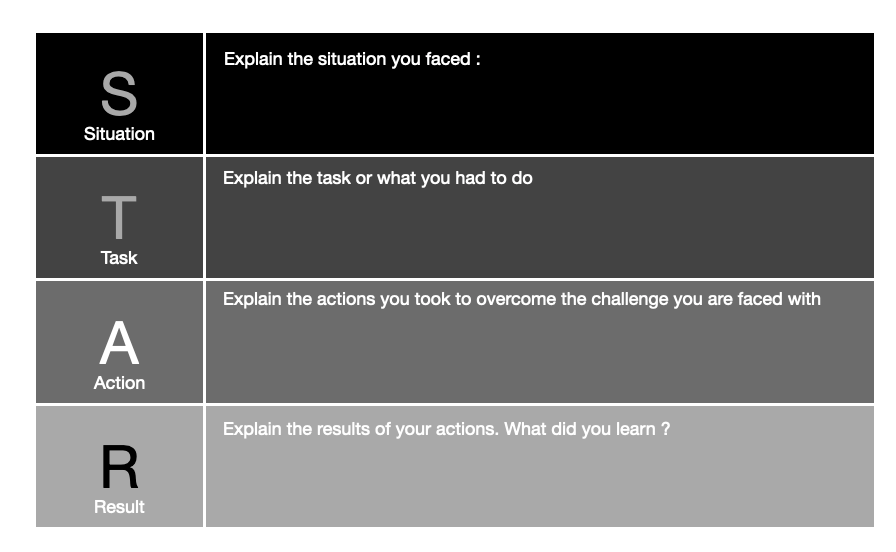30/36 - ✨Product Manager Interview Framework
STAR: Succeeding through Situations, Tackling Tasks, Taking Actions, and Realizing Results.
What is the STAR framework?
The STAR framework helps you give concise and relevant answers to a range of job interview questions. Each framework element connects with the others to help you tell a compelling story. This STAR approach can demonstrate how past behavior has developed your learning and professional experience. With practice and preparation, you can determine how much information to share about your accomplishments.
Here’s what each element means:
Situation: A specific event or situation when you needed to accomplish something.
Task: The goal you (or your team) were working toward.
Action: The actions you took to solve a problem or contribute to achieving a goal.
Result: The outcome of your actions and positive results you can take credit for.
How to approach STAR Framework
Knowing what the acronym stands for is only the first step—you need to know how to use it. Follow this step-by-step process to give the best STAR interview answers.
Find a Suitable Example The STAR interview method won’t be helpful to you if you use it to structure an answer using a totally irrelevant anecdote. That’s why the crucial starting point is to find an appropriate scenario from your professional history that you can expand on.
Lay Out the Situation With your anecdote selected, it’s time to set the scene. It’s tempting to include all sorts of unnecessary details—particularly when your nerves get the best of you. But if the interview asks you to tell them about a time you didn't meet a client's expectations, for example, they don't necessarily need to know the story of how you recruited the client three years earlier or the entire history of the project.
Your goal here is to paint a clear picture of the situation you were in and emphasize its complexities so that the result you touch on later seems that much more profound. Keep things concise and focus on what’s undeniably relevant to your story.
Highlight the Task You’re telling this story for a reason—because you had some sort of core involvement in it. This is the part of your answer when you make the interviewer understand exactly where you fit in.
This can easily get confused with the “action” portion of the response. However, this piece is dedicated to giving the specifics of what your responsibilities were in that particular scenario, as well as any objective that was set for you, before you dive into what you actually did.
Share How You Took Action Now that you’ve given the interviewer a sense of what your role was, it’s time to explain what you did. What steps did you take to reach that goal or solve that problem?
Resist the urge to give a vague or glossed-over answer like, “So, I worked hard on it…” or “I did some research…”
This is your chance to really showcase your contribution, and it’s worthy of some specifics. Dig in deep and make sure that you give enough information about exactly what you did. Did you work with a certain team? Use a particular piece of software? Form a detailed plan? Those are the things your interviewer wants to know.
Dish Out the Result Here it is—your time to shine and explain how you made a positive difference. The final portion of your response should share the results of the action you took. Of course, the result better is positive—otherwise, this isn’t a story you should be telling. No interviewer will be dazzled with an answer that ends with, “And then I got fired.”
Does that mean you can’t tell stories about problems or challenges? Absolutely not. But, even if you’re talking about a time you failed or made a mistake, make sure you end on a high note by talking about what you learned or the steps you took to improve.
5 behavioral interview & STAR answers
1. Tell me about a time you had a conflict at work.
STAR Model Answer: There was a disagreement I had with a coworker which originated from a miscommunication. To keep our work environment professional and positive, we had to discuss it and make amends. I sat down with them one day during lunch, paid for their meal, and took initiative by apologizing for my part in the whole mess. Now, we work together well and are often praised for our impressive teamwork.
2. Can you describe a stressful situation and how you handled it?
STAR Model Answer: At my last restaurant, I once found out mere hours in advance about a health inspection. As the head chef, I was in charge of making sure everything was in order in the kitchen and the BOH before the inspector arrived. I quickly called in employees from the last shift to help out, leaving the others available to prep for that evening’s dinner. As a result, we were able to ace the inspection, less costly in the long run compared to giv ing employees a few hours of overtime.
3. Can you detail a mistake you made and how you reacted to it?
STAR Model Answer: One time, I switched the packing labels of two packages I sent to customers. I had to correct the problem without angering the clients. I called them both up and provided them with shipping labels with the correct addresses while offering each of them a small gift certificate to use on a future order. The customers not only helped me fix my mistake, but they were both satisfied and will return and shop again.
4. Tell me about a time when you performed well under enormous pressure.
STAR Model Answer: At my last job, my coworker needed to miss work for some time, and their project was left unfinished and without a manager. My supervisor instructed me to take on the project, and with no leniency on the deadline, I had days to complete a project that originally should have taken several weeks. I requested and was granted reduced weekly goals, giving me more time to finish the special project. As far as my weekly goals, I was able to delegate them out to teammates. With my reduced goals, I dedicated more time to the special project. This allowed me to finish it on time and with complete accuracy. My supervisor appreciated my attitude and drive, and I was given several more projects after that, along with an eventual promotion and pay raise.
5. Have you ever dealt with a sticky situation involving another department?
STAR Model Answer: Previously, my department had a misunderstanding with members of our accounting department. We needed to correct the issue to keep office morale from plummeting. I gave my team a small budget and instructed my team to each pick out a thoughtful present for their counterpart in accounting. Later that night and from then onward, we became friends and strong colleagues.
Steps to create your own STAR framework
Familiarizing yourself with the STAR framework will help you build confidence as you prepare for job interviews. In addition, following it will help you tell the story of why you’re not only the ideal person for the job but the missing link in the team.
Get started by selecting the STAR Template, and customizing the default framework as needed. If STAR isn’t your preferred framework, you can instead adapt the headings to “CARL” (Challenge, Action, Result, Learning) or “PAR” (Problem, Action, or Result).
Think of recent professional situations that can make the case for you as an optimal candidate. These can broadly fall under demonstrating behaviors in leadership, teamwork, initiative, planning, and customer service.
Draft up short descriptions of each situation so you can recall them easily. Add some details with Miro’s sticky notes feature if you need more in-depth answers.
Check that each example follows a storytelling structure. Remember, you need a beginning, middle, and end. How did the situation and task lead to action and results?
Do a positivity check. Maybe the results didn’t turn out as planned. That’s okay – what did you do that still reflected positively on yourself as an individual and team player?
Keep it honest. If asked about a situation you’ve never been in before, map out the Situation, Task, and Action sections with how you plan to handle the challenge. You can also discuss metrics you’d use to measure success.
Include details. Give a detailed account of a specific situation – this will build a stronger case for you than broad generalizations. You can use comments on top of text boxes or sticky notes to add more information.
Demonstrate experience from different roles and times in your career. Try to point to experience in other industries, leading by example, working on tools, or contributing to team culture. These can be color-coded with sticky notes to coordinate details when you need to recall them at the moment.
Title: Enhancing Airbnb Experiences with Google's Mapping Expertise
STAR Framework:
Situation (S):
Airbnb is a global platform for lodging and travel experiences, with millions of listings worldwide.
Airbnb's hosts often face challenges in providing accurate location information to guests.
Google is renowned for its mapping and data analytics capabilities, with Google Maps being a household name.
Task (T):
Airbnb wanted to improve user experiences by addressing location-related challenges and enhancing the booking process.
Google had the expertise to provide robust mapping solutions and data analytics insights.
Action (A):
Airbnb and Google entered into a strategic partnership to leverage Google's mapping expertise.
They introduced the "Location Clarity" initiative, aiming to make Airbnb listings more precise and informative.
Host Assistance Tool: Airbnb integrated Google Maps into its host dashboard. Hosts could now use Google Maps to pinpoint the exact location of their listings, eliminating the ambiguity often associated with addresses. This action simplified check-ins for guests and enhanced host credibility.
Neighborhood Insights: Airbnb incorporated Google's data analytics capabilities. When users searched for accommodations, they could access detailed "Neighborhood Insights" powered by Google. This included data on local attractions, public transport, and safety ratings. Users could also view a virtual tour of the neighborhood via Google Street View.
Result (R):
Improved User Experience: The collaboration significantly improved the user experience. Travelers reported increased confidence in their bookings due to the precise location information and virtual neighborhood tours. This resulted in a 20% decrease in booking cancellations.
Streamlined Check-Ins: The host assistance tool led to a 30% reduction in check-in issues and late arrivals. This was particularly beneficial for hosts who had previously struggled with guests finding their properties.
Enhanced Host Satisfaction: Hosts appreciated the simplicity of using Google Maps and the additional neighborhood insights. Many reported feeling more competent as hosts, which led to better reviews and higher booking rates.
Economic Impact: The collaboration had a positive economic impact. Airbnb hosts who adopted the host assistance tool saw a 15% increase in bookings due to improved location accuracy. This also led to a 10% increase in host revenue.
Strengthened Partnership: Airbnb and Google strengthened their partnership by expanding into other areas, such as integrating Google's machine learning algorithms to recommend personalized local experiences for travelers.
Conclusion: The collaborative efforts of Airbnb and Google in improving location accuracy and enhancing user experiences resulted in significant benefits for both companies and their users. This case study demonstrates how a strategic partnership can leverage the strengths of two industry leaders, ultimately leading to improved customer satisfaction and business growth.



